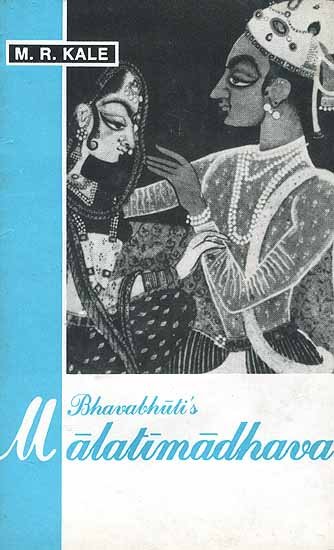Malatimadhava (study)
by Jintu Moni Dutta | 2017 | 52,468 words | ISBN-10: 8120813057 | ISBN-13: 9788120813052
This page relates ‘Literary Study (Conclusion)’ from the English study on the Malatimadhava of Bhavabhuti:—A Prakarana type of Drama in ten acts revolving around the love-story of Malati (from Padmāvatī) and Madhava (from Vidarbha). This study discusses the history of its author and the literary, social, religious, historical and cultural aspects of the Malatimadhava.
Literary Study (Conclusion)
From the detailed observation it has been revealed that Bhavabhūti has delineated Śṛṅgāra rasa as the principal sentiment. He also successfully has delineated both types of Śṛṅgāra s rasa. He shows to be an expert in the combination of allied and contrary rasas. He has introduced Vīra rasa to aid the development of śṛṅgāra. Even he dexterously delineated Bībhatsa rasa in the progress of Śṛṅgāra rasa. Here the change from Śṛṅgāra rasa to Bībhatsa rasa is gradually effected without a hitch through the intervention of Adbhuta. Bhavabhūti also shows how the change from Bībhatsa to the predominant sentiment Śṛṅgāra, is skilfully brought about through the intervention of other rasas— Bhayānaka, Karuṇa, Adbhuta, Raudra and Vīra- all of them developed only to a small extent and made ancillary to the main Śṛṅgāra. Hence, a successful delineation of Śṛṅgāra rasa with other rasas is found in the Mālatīmādhava.
However the Hāsya rasa is totally absent from the drama. Generally Sanskrit dramas have the character of the Vidūṣaka for evoking the Hāsya rasa (comic sentiment). The Vidūṣaka plays the role of a friend of the hero and assists him in his love affair. But the character Vidūṣaka is not found in any of all the three plays of Bhavabhūti. Bhavabhūti was a learned Brāhmaṇa and also attained Vedic scholarship. He did not like to bring a gluttonous and clumsy Vidūṣaka on the stage, who is a Brāhmaṇa only by name and a disgrace to his caste and make him a laughing stock of the spectators. So he must have omitted this character from all his plays. Bhavabhūti was a man of grave nature. He had to suffer several hardships in his life and had to fight an uphill battle for fame. He had thought deeply and long over the problems of life and had come to the conclusion that fate reigns supreme in the affairs of men. He has given expression to this belief in several places in his plays. Moreover, the Śānta rasa is also not found. Yet, Bhavabhūti has acquired all success in delineating the principal sentiment Śṛṅgāra. In this regard Winternitz remarks that in this drama Bhavabhūti has understood more deeply and more seriously erotics than has been by most of the Indian poets.[1]
It can be noted that in the Mālatīmādhava,Bhavabhūti has not enabled to delineate Karuṇa rasa so successfully as in the Uttararāmacarita.However in the 9th act Mādhava is found to have overwhelemed with grief in his separation from beloved who is believed to be dead. He bursts into violent bewailings and turns towards the animals of forest and the clouds in the sky in the belief that they must be sympathetic towards him in his grief. In the Uttararāmacarita, Bhavabhūti has delineated the Karuṇa rasa so successfully that having seen the sorrow of Rāma,even a stone would weep and the heart of adamant breaks into pieces. Bhavabhūti’s diction and his description of the emotion roused by sorrow are appropriately noble and moving. However, manifestation of Karuṇa rasa is not extolled in the Mālatīmādhava.
Bhavabhūti has displayed his excellence in the employment of alaṃkāras in the Mālatīmādhava. He has used Śleṣālaṃkāra, Yamaka, Apahnuti, Aprastutapraśaṃśā, Viśeṣa and Yathāsaṃkhya alaṃkāra in only a few places whereas Upamā, Utprekṣā, Virodha, Kāvyaliṅga, Samucchaya, Svabhāvokti are used in an extensive form.
It is found that Vaidarbhī Rīti is appropriate in descriptions suggestive of the Śṛṅgāra and Karuṇa rasas while the Gauḍī is suitable for that of the Vīra, Raudra and Bībhatsa rasas. Bhavabhūti has strictly followed this rule in his works. In the Mahāvīracarita, he has delineated Vīra rasa as predominant sentiment and other rasas like Raudra, Bībhatsa as subordinate ones. Hence Bhavabhūti has composed the verses in that play in the Gauḍī rīti. On the other hand, in the Mālatīmādhava, he has delineated Śṛṅgāra rasa and in the Uttararāmacarita the Karuṇa rasa as the predominant rasas. So in both these plays he has composed the verses in Vaidarbhī rīti. It is interesting to note that Bhavabhūti has used the Gauḍī rīti not only in the Mahāvīracarita where the Vīra rasa is the main sentiment but also in the Mālatīmādhava, in passages where the Śṛṅgāra rasa is to be suggested. In some places descriptions full of long compounds appear quite inappropriate. For instance, the detailed account of the confusion caused by a tiger which escaped from its cage is found in full of long compounds.
Bhavabhūti has employed a large number of metres in the Mālatīmādhva with equal skill. Here he has employed the lengthy metre Daṇḍaka in appropriate form in the description of the goddess Karālā. Again he has used other long metres like the Sragdharā and the Śārdūlavikrīḍita for the description of the Vīra, Raudra and Bībhatsa rasas but for the reconciliation of angry persons he has employed short metres like Rathoddhatā. He has used the metres Mandākrāntā, Hariṇī and Māliṇī for the delineation of the softer sentiments.
In the Suvṛttatilaka, Kṣemendra has commended Bhavabhūti’s use of the Śikhariṇī metre—
bhavabhūteḥ śikhariṇī nirargalataraṅgiṇī /
rucirā ghanasandarbhe yā mayūrīva nṛtyati//
But in the Mālatīmādhava, not so many verses are found in this metre.
Footnotes and references:
[1]:
Vide, M. Winternitz. History of Sanskrit Literature, p.263
